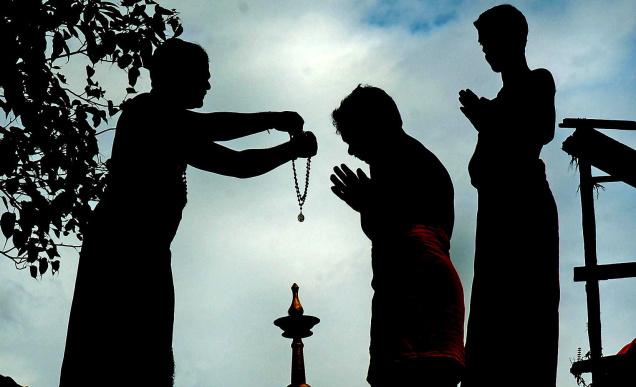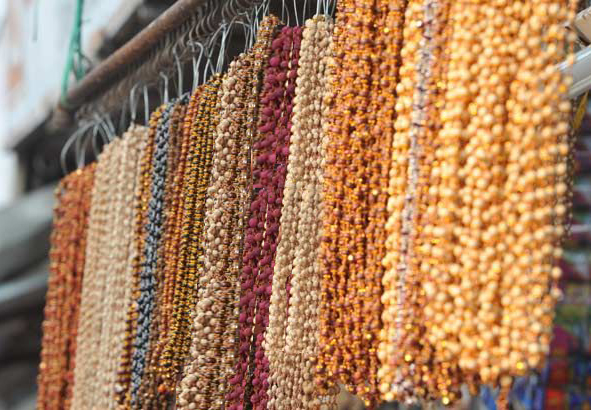Sabarimala Pilgrimage | The austerities that pilgrims observe
Hindus believe that periodic Vrithams (austerities observed for a certain period of time) have the power to purify one’s mind and body. A Sabarimala pilgrim is required to observe strict austerities for 41 days before climbing the holy 18 steps of the temple.

A Sabarimala pilgrim receives his mudra mala (holy chain made of Rudraksham beads) from his Guruswami.
The Vritham typically begins on the first day of the Malayalam month of Vrishchikam. Since the temple also opens on that day for the annual pilgrimage devotees who aspire to get the darshan of the Lord on that day, start the vritham 41 days in advance. A Sabarimala pilgrim is also addressed as Ayyappan. It is the most beautiful aspect of this pilgrimage. The pilgrim who observes austerities to obtain the darshan of Ayyappan also becomes an Ayyappan. A devotee who is on his first pilgrimage to Sabarimala is called a Kanni Ayyappan. Female devotees are addressed as Malikappuram in honor of the Goddess Malikappurathamma installed outside the temple.
Read about the unique customs and traditions of Sabarimala pilgrimage here.
Sabarimala Pilgrimage
Austerities (vritham) are an important part of the Sabarimala pilgrimage. The austerities are designed to purify the body and the mind. A pilgrim has to follow a strictly vegetarian diet during these 41 days. They are required to subsist on as little as possible. They must not use profanities or get angry. They must not pick a fight or slander others. In addition, pilgrims should abstain from drinking and observe celibacy while they are on vritham.
Before commencing the 41 day vritham a devotee has to seek the permission of his parents and guru. All devotees start the vritham on an auspicious day and on the eve of that day they visit the temple of their family deity and offer pujas. Coins worth 1.25 rupees are wrapped in a piece of yellow cloth. A knot is then made using this cloth. This is also offered to the family deity to gain his/her approval for the pilgrimage.
The Sacred Mala
‘Malayidal’ (the wearing of the holy chain made of Tulsi or Rudraksham beads) is an important part of the Vritham. Rudraksham indicates renunciation. It is common for Hindu sages to wear this holy bead around their arms and neck. Most devotees start wearing this chain of beads from the first day of the vritham. However, some wait until a few weeks before they start the holy trek. Pilgrims only wear black or blue clothes after the ‘Malayidal’ ceremony is over. Most devotees start wearing this chain on a Saturday. It is believed that Ayyapan was born on a Saturday. It was also the first day of the month of Vrishchikam (associated with the zodiac sign Scorpio) and the star associated with that day was Uthram. Wearing the holy chain (mala) on one of these days (on a Saturday, on the first day of Vrishchikam or on Uthram) is considered auspicious.

Sacred malas displayed at a store. Each Sabarimala pilgrim wears a mudra mala (sacred chain). Once a pilgrim wears the mala he becomes Lord Ayyappan himself and the austerities begin.
The devotee receives the mala from a Guruswami. A Guruswami is a pilgrim who has undertaken the pilgrimage at least three times. Most devotees choose aged pilgrims in their neighborhood as their Guruswami. The malayidal ceremony is usually performed at a temple or another holy place.
While wearing the holy mala, the pilgrim vows total submission to Ayyappan and starts considering himself as a personification of the Lord. This requires him to purify his thoughts, words and deeds by leading the life of an ascetic.
The pilgrim is required to get up early in the morning, take a bath and offer prayers to his family deity, the navagrahas (the nine planets) and the holy mala he is wearing. Just like Ayyappan who dwells in the hills with no company, an Ayyappa devotee is also required to lead an ascetic life during these days of austerities. This, however, does not mean that he should isolate himself from friends or family. He can go about his life as usual but he is also required to find time for prayers and pujas. He is required to visit temples, feed and help the poor and listen to spiritual sermons. In short, the devotee should immerse himself in activities that will purify his body and mind and stay away from those activities that pollute his mind. Observing celibacy is a must. The devotee is also required to abstain from alcoholic beverages, smoking and substance abuse.
The devotee will wake in the wee-hours of the day, apply vibhoothi (holy ash) and sandalwood paste on his body and chant the names of Ayyappa. He will refrain from hurting others either physically or verbally and treat everyone as the living incarnations of the Lord Ayyappa himself. An Ayyappa swami does not wear sandals or shoes. He sleeps on the bare floor or a mat and does not oil his hair or body. Neither does she remove his facial, cranial and body hair during these days.
Aazhi pooja/Vellamkudi

An ecstatic Sabarimala pilgrim sprays the cinders while participating in an Aazhi Puja (fire worship)
The Sabarimala pilgrimage has just one objective – the purification of the mind. The austerities are performed with the objective of controlling bodily desires and elevating the mind into a higher realm of existence. For Hindus, the ultimate goal of life is the attainment of oneness with the Supreme Power. According to Hinduism, all that exists is one. This is exactly what sages meant when they uttered the words Aham Brahmasmi (I am the Supreme Power/Brahman) and Tatwamasi (You are the Supreme Power / Brahman). Unfortunately, our attachment to our body and material possessions prevent us from experiencing the blissful nature of our soul and as a result we lead miserable lives without any contentment.
By leading the life of an ascetic a Sabarimala pilgrim learns to conquer at least some of his desires and reaches a higher frame of mind. Aazhi Pooja is a ritual performed to celebrate this attainment of purity of mind. It is performed on an auspicious day before the actual pilgrimage begins. This ritual is also known as Daham Veppu (the quenching of thirst), Vellamkudi (the act of drinking of water) and Padukka. Because of our attachment to our body, we are always longing for the satisfaction of various desires. These unquenched thirsts impede our spiritual progress. A devotee who can conquer these thirsts or desires can experience pure bliss. Since the Sabarimala devotees lead an austere life for several weeks, they attain considerable purification of their body and mind.
Aazhi means blazing fire. This ritual is performed in a special pandal (a makeshift pavilion). The fire is started by igniting camphor and as it rages, the pilgrims will circumambulate it chanting ‘Swamiye Saranam Ayyappa’ (Ayyappa Swami is our refuge). When camphor is burned it leaves no traces behind. Because of this reason, it is used for pujas. It is symbolic of the total destruction of material desires. Coconuts and rice flakes are thrown to the fire to keep it blazing. Here the all consuming flames represent Lord Ayyappan and the articles thrown into it are the material desires that need to be annihilated. Some ecstatic Ayyappas even walk on the aazhi (fire) out of their devotional fervor.